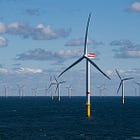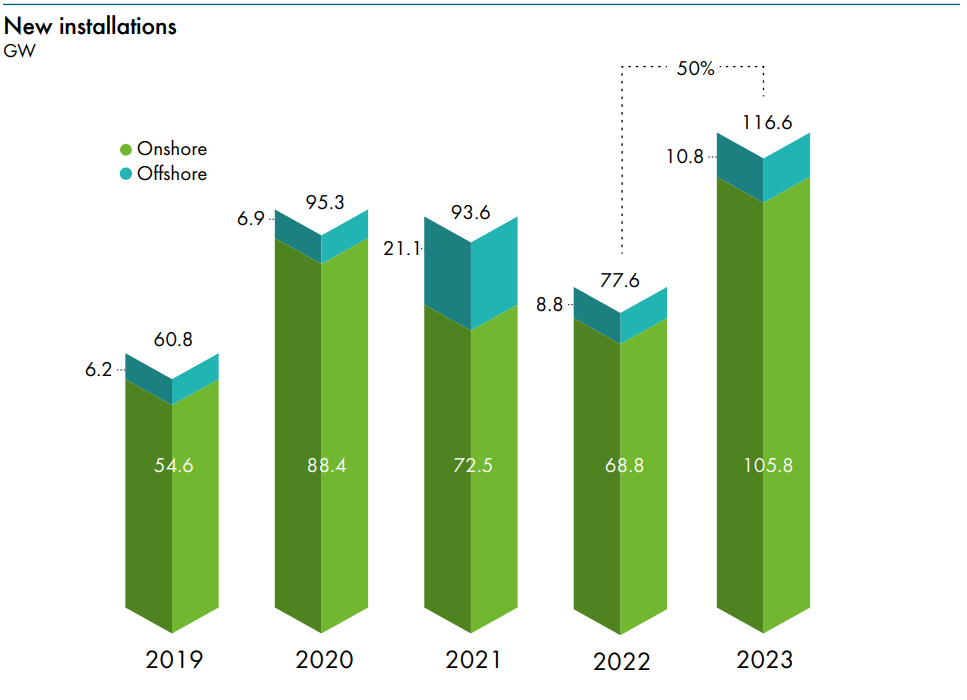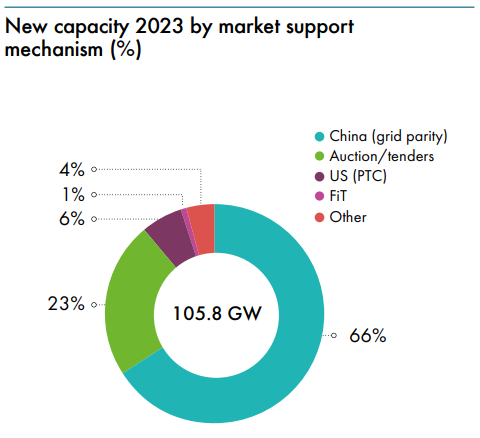Windletter #78 - The world installed 116 GW of wind power in 2023. China installed the 65%
Also: offshore auction of 6 GW in Denmark, new floating platform by BW Ideol, Mingyang's double-rotor floating platform, and more.
Hello everyone and welcome to a new issue of Windletter. I'm Sergio Fernández Munguía (@Sergio_FerMun) and here we discuss the latest news in the wind power sector from a different perspective. If you enjoy the newsletter and are not subscribed, you can do so here.
Windletter is sponsored by:
🔹 Tetrace. Specialized services in operation and maintenance, engineering, supervision, inspection, technical assistance, and distribution of spare parts in the wind sector. More information here.
🔹 RenerCycle. Development and commercialization of solutions and specialized services in the circular economy for renewable energies, including comprehensive dismantling of wind farms and waste management, refurbishment and sale of components and wind turbines, management and recycling of blades and others. More information here.
Windletter está disponible en español aquí
The article by Eize de Vries in Windpowermonthly about the Siemens Gamesa prototype of 21 MW, the interview of Juan Virgilio (CEO of AEE) in Energía Estratégica, and the video of the wind farm with a spectacular civil work in South Korea.
A reminder: if you haven't read the latest editions or the last Windstory we published, check your inbox (including the promotions and spam folders), as sometimes filters can play tricks...
And now, as good manners dictate, let's move on to the news of the week, which come soaked with a strong offshore presence.
🌍 The world installed 117 GW of wind power in 2023, the best year in history
As every year, the GWEC (Global Wind Energy Council) has released its annual Global Wind Report, which provides an overview of the state of the wind energy sector worldwide, including statistics, challenges, and future prospects.
The report focuses on providing solutions and tools to achieve the goal of tripling renewable energy installations by 2030. Wind energy is, of course, crucial to this objective.
It is a comprehensive report with a lot of information covering topics such as investment and financing, supply chain, grids, social impact... and, of course, statistics.
It is really worth taking a look at it because it provides numerous real-life examples and links to many sources for further information.
So, just like we did in edition #72 with the wind power numbers in Europe, let's dissect and highlight some key points from the GWEC report, specifically from the statistics section.
▶ The world installed 116.6 GW of new wind power capacity in 2023, a 50% increase compared to 2022, which is no small feat.
▶ According to data from the GWEC, the world had 1,021 GW of installed wind power capacity as of the end of 2023. From 2022 to 2023, there was a 13% growth. Kiko Maza's insights on the journey to reach 1,000 GW are quite interesting.
▶ Onshore wind surpassed 105 GW in installations (the best year in history), while offshore wind approached 11 GW (the second best year in history after 2021). There's a stark difference, even though offshore is the trending technology and attracts most of the attention.
▶ Thanks to the strong rebound in new installations in China and India, the Asia-Pacific region consolidated its position as the largest wind power market worldwide with a 71% market share.
▶ Europe was the second region with the most installations, thanks to its 18.3 GW, which drops to 16.2 GW if we only consider the EU. North America closes the podium with 7% of global installations.
▶ The top 5 countries in terms of installations are China, the United States, Brazil, Germany, and India. These 5 countries account for 82% of global installations.
▶ The end of feed-in tariffs. For years, feed-in tariffs were responsible for showcasing wind projects with very low risk. States guaranteed a tariff per MWh that allowed projects to move forward. However, the arrival of auctions made them disappear from the map, as seen in the following graph.
The case of China is peculiar, as it still has a kind of feed-in tariff: wind farms receive the same tariff as coal-fired power plants, known as grid parity.
▶ In 2023, 39.4 GW of offshore wind were awarded worldwide. Excluding China, where 18.2 GW were awarded with the grid-parity system, the remaining 21.2 GW were awarded in Europe (15.5 GW), the United States (4 GW), and Japan (1.4 GW).
▶ For this year 2024, GWEC expects new installations to surpass the previous record with 130 GW installed. The number of installed GW would increase to reach 182 GW by 2028.
▶ Regarding forecasts by regions, Asia-Pacific, despite being the largest by far in numbers, is the slowest growing region in percentage terms.
🌊 Denmark launches an offshore auction with enough capacity to meet the country's entire demand
Last week, Denmark launched an offshore wind auction that could award up to 6 GW, enough to meet the country's electricity needs.
Currently, Denmark has 2.7 GW of offshore wind capacity, so this auction could triple that figure. The tender includes six areas, three in the North Sea, two in the Kattegat, and one in the Baltic Sea.
One curiosity about this auction is that promoters have the option to install more GW than those awarded, so that the additional capacity can be used to produce renewable hydrogen and other derivatives. The Danish state itself estimates that up to 10 GW could be awarded.
However, the allocation system is based on a somewhat curious negative bidding system. Promoters will bid an annual payment for 30 years for the right to use the marine space, and logically, the highest bidders will be the winners.
This could result in considerably higher project costs, depending on the risk participants are willing to take, potentially leading to lower installed capacity. Additionally, the state will have a 20% ownership in the parks, though I'm unsure through what formula.
Another interesting point is that the auction also includes social and environmental criteria (non-price criteria) for the prequalification of participants.
For those who are unfamiliar with negative bidding, we discussed it in edition #48, including its advantages and disadvantages (sorry it is available only in Spanish, Windletter was not published in English at that time, but you can still use Google Translate 🙂).

Windletter #48 - Negative bidding sí o no: ¿se está pagando demasiado por instalar eólica offshore?
_
🗨️ Interview with Jose Luis Blanco, CEO of Nordex and President of WindEurope, in CincoDías
The Spanish newspaper CincoDías interviewed Jose Luis Blanco, CEO of Nordex and President of WindEurope, touching on some of the main topics in the industry and also focusing on the Spanish market.
It's worth taking a look at the interview, but I'll highlight a topic that perhaps isn't discussed as much as others.
What do you think about regional taxation on renewables?
Taxes are paid by the end consumer. The investor has to analyze the profitability of their investment project, and undoubtedly, if there are associated taxes, they will be passed on to the cost and consequently to the price that the end consumer will pay. As an association, we are not in favor of increasing that tax burden on the sector.
When these types of taxes are created, there is a perception (or the message is conveyed) that "the big power companies" pay the taxes, but the reality is that, one way or another, the majority end up being passed on to the consumer.
In edition #71, we discussed the taxes paid by wind farms in Aragon in recent years.
I have had an article in draft form for some time to discuss and list how many taxes a wind farm pays in Spain. If you don't want to miss it, subscribe.
_
🌀 BW Ideol launches its updated design of floating platform for 15 MW+ wind turbines
During the Floating Offshore Wind Turbines (FOWT) event held recently in Marseille, BW Ideol unveiled the update of its floating platform called Damping Pool. It is a barge-type platform made of concrete.
This platform has been in operation since 2018 with two prototypes in France and Japan, and now it's being updated to accommodate 15 MW+ wind turbines. Additionally, BW Ideol is currently constructing a pilot project (Eolmed) in France with a capacity of 30 MW, including 3 units of its foundation for V164-10.0 MW wind turbines, which is expected to be commissioned later this year.
According to BW Ideol's website, the new platform comes in 3 classes adapted to different environmental conditions. The advantages of this platform include limited dimensions (54 meters, presumably in length and width) and shallow draft, less than 12 meters when operational.
Along with the platform, BW Ideol has also introduced a manufacturing process described as "easily scalable and replicable in multiple port infrastructures."
A few months ago, we discussed how BW Ideol CEO Paul de la Guérivièr pointed out that concrete is the only way forward for large-scale European floating wind energy.
_
🔧 Mingyang starts installation of a double-rotor floating platform
Continuing with floating wind power, Mingyang has begun installing a double-rotor floating wind platform with a capacity of 16.6 MW off the southern coast of China.
The design consists of a platform with space for two turbines, in this case Mingyang MySE8.3-180, giving the platform a total capacity of 16.6 MW. According to Mingyang, this makes the floating platform the world's most powerful.
OceanX, also known as Nezzy², is an Aerodyn’s design licensed to Mingyang. In fact, Aerodyn already tested a 1/10 scale prototype in Germany in 2020, as shown in the image below.
Aerodyn is also the inventor of the Super Compact Drivetrain, which Mingyang has used in many of its models.
The platform is expected to be operational during the first half of 2025.
Related to this, I came across an interesting reflection by Bruno G. Geschier on LinkedIn regarding the development of floating wind platforms. According to Bruno, OEMs (Original Equipment Manufacturers) could be one of the bottlenecks for such developments, as they "don't have time or resources to invest in a small floating project."
And Bruno's point makes sense because OEMs currently have other priorities to invest their resources in.
Apart from resources, Mingyang's case with OceanX is different because in this case, they own both the wind turbines and the platform.
_
💨 Australia grants viability licenses to 12 offshore wind projects with a capacity of up to 25 GW
Exciting news about offshore wind power comes from Australia. The Australian government has granted viability licenses to 12 projects totaling a capacity of up to 25 GW.
Australia is clearly an attractive market and considered low-risk, as virtually all major global players are there: CIP, Corio, Iberdrola, Ocean Winds, RWE, BlueFloat Energy, Ørsted...
The granting of these licenses concludes a 15-month process since the beginning of the application. Six of them are ready to proceed with development, while the remaining six still require some approvals.
The following map from Aegir Insights shows the areas and promoters:
The next steps in development involve conducting more detailed investigations of the locations and seabed, definitive wind measurements, licenses for electrical infrastructure... and many more things, as you can imagine.
It is expected that in 2024, the state of Victoria will hold an auction in which some of these projects (the most advanced ones) can participate.
Developers seem eager to share good news in the offshore sector, as most of them have quickly celebrated on their social media platforms, even though there is still a long way to go before these wind farms materialize.
_
⚠️ Video of a rescue maneuver in a wind turbine
This week's curiosity has to do with safety. And although the video is 11 years old and has nearly 800,000 views, I think it's worth bringing it up here.
The video shows a rescue maneuver in a wind turbine in the United States. For the curious, if I'm not mistaken, it's a Siemens SWT-2.3-93 (known as the G2 platform).
For those who have taken the GWO course before, you'll know that these types of maneuvers are not easy for someone inexperienced. And I can't even imagine the pressure of the moment in a real-life situation 😅.
Furthermore, as if that weren't enough, in this case, the person being rescued is hanging halfway up the tower.
Note, although it may not seem like it (the "actor" being rescued does really well), this is a drill. According to what they say in the video, the maneuver lasted 12 minutes from the moment the rescuer was inside the nacelle until they touched the ground.
Thank you very much for reading Windletter and many thanks to Tetrace and RenerCycle, our main sponsors, for making it possible. If you liked it:
Give it a ❤️
Share it on WhatsApp with this link
And if you feel like it, recommend Windletter to help me grow 🚀
See you next time!
Disclaimer: The opinions presented in Windletter are mine and do not necessarily reflect the views of my employer.

















